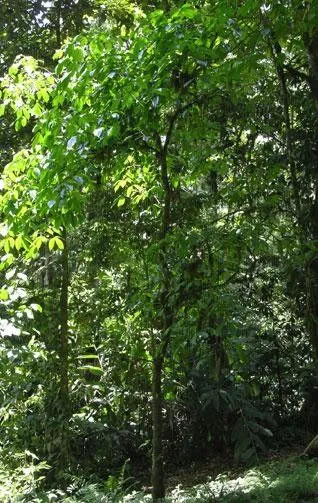
Author: L.
Bibliography: Sp. Pl.: 444 (1753)
Year: 1753
Status: accepted
Rank: species
Genus: Crateva
Vegetable: False
Observations: Mexico to Trop. America
The Crateva tapia, commonly known as the Garlic-pear, is a remarkable flowering plant that belongs to the family Capparaceae. First described in 1753, this species has garnered interest due to its distinctive characteristics and geographical distribution.
The Garlic-pear is native to regions stretching from Mexico to tropical parts of the Americas, where it thrives in the warm, humid conditions typical of these areas. This plant is recognized for its resilience and adaptability, often found growing in a variety of landscapes, from lowland forests to riverbanks.
Crateva tapia is notable for its eye-catching white to yellow blossoms, which are integral to its appeal. The flowers are fragrant and attract various pollinators, which are essential for the propagation of the species. The plant’s leaves are compound, typically trifoliolate, and contribute to its lush, green canopy.
Another significant feature of the Garlic-pear is its fruit, which resembles a small pear and contains a pungent smell, reminiscent of garlic. This unique scent is the characteristic that lends the plant its common name. The fruit is not only interesting from a botanical standpoint but also holds cultural and medicinal importance in certain indigenous communities throughout its range.
In terms of ecological importance, the Garlic-pear provides food and habitat for a variety of wildlife species. Its flowers serve as a nectar source for bees and other pollinators, while the foliage can offer shelter to smaller organisms. Additionally, the fruits can be a food source for birds and other animals within its native habitat.
Crateva tapia’s integration into local cultures can be observed in its various uses. Traditional medicine often employs different parts of the plant for their therapeutic properties, addressing ailments ranging from respiratory issues to digestive disorders. Moreover, the plant has potential applications in landscaping, valued for its ornamental flowers and hardiness.
Overall, the Garlic-pear is an intriguing species that exemplifies the diversity and adaptability of the Capparaceae family. Its vibrant presence from Mexico to tropical America highlights its significance within these ecosystems, making it a subject of continued interest for botanists and nature enthusiasts alike.
Spa: naranjuelo
Por: capança, catauré, fruto-de-macaco, trapiá
Eng: garlic-pear
En: Garlic-pear
Pt: Capança, Catauré, Fruto de macaco, Trapiá, Fruto-de-macaco
Es: Naranjuelo
Taken Apr 17, 2019 by OTS – O. Vargas (cc-by-nc-sa)
Taken Dec 25, 2021 by Vanessa Pecorelli (cc-by-sa)
Taken Mar 8, 2020 by Krishna Krishnaveni Varada (cc-by-sa)
Taken Apr 17, 2019 by OTS – O. Vargas (cc-by-nc-sa)
Taken Apr 17, 2019 by OTS – O. Vargas (cc-by-nc-sa)
Taken Apr 17, 2019 by OTS – O. Vargas (cc-by-nc-sa)
Taken Dec 25, 2021 by Vanessa Pecorelli (cc-by-sa)
Taken Aug 1, 2014 by Nelson Zamora Villalobos (cc-by-nc)
Taken Aug 1, 2014 by Nelson Zamora Villalobos (cc-by-nc)
© copyright of the Board of Trustees of the Royal Botanic Gardens, Kew.
© copyright of the Board of Trustees of the Royal Botanic Gardens, Kew.
© copyright of the Board of Trustees of the Royal Botanic Gardens, Kew.
Taken Apr 17, 2019 by OTS – O. Vargas (cc-by-nc-sa)
Taken Nov 6, 2011 by AMAP Lab – Guyane 2022 (cc-by-sa)
Taken Nov 6, 2011 by AMAP Lab – Guyane 2022 (cc-by-sa)
Taken Nov 6, 2011 by AMAP Lab – Guyane 2022 (cc-by-sa)
Taken Nov 6, 2011 by AMAP Lab – Guyane 2022 (cc-by-sa)
Taken Nov 6, 2011 by AMAP Lab – Guyane 2022 (cc-by-sa)
Taken Apr 17, 2019 by OTS – O. Vargas (cc-by-nc-sa)
Family: Myrtaceae Author: (F.Muell.) K.D.Hill & L.A.S.Johnson Bibliography: Telopea 6: 402 (1995) Year: 1995 Status:…
Family: Rubiaceae Author: Pierre ex A.Froehner Bibliography: Notizbl. Bot. Gart. Berlin-Dahlem 1: 237 (1897) Year:…
Family: Sapindaceae Author: Koidz. Bibliography: J. Coll. Sci. Imp. Univ. Tokyo 32(1): 38 (1911) Year:…
Family: Asteraceae Author: A.Gray Bibliography: Pacif. Railr. Rep.: 107 (1857) Year: 1857 Status: accepted Rank:…
Family: Fabaceae Author: Medik. Bibliography: Vorles. Churpfälz. Phys.-Ökon. Ges. 2: 398 (1787) Year: 1787 Status:…
Family: Aspleniaceae Author: (Cav.) Alston Bibliography: Bull. Misc. Inform. Kew 1932: 309 (1932) Year: 1932…